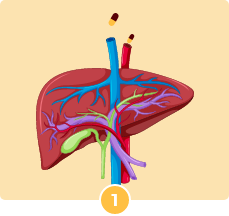What Is TAFSAFE?

TAFSAFE May:
- Lower The Amount Of HBV In Your Body
- Improve The Condition Of Your Liver
How TAFSAFE Works
How it works:

TAFSAFE was designed in a way that allows it to travel to the liver before becoming active.

Once at the liver, most of the medicine is activated within the liver cells

Tafsafe then works in the liver cells, right where the hep B virus is
How to Take It
Here are some tips to help you remember:

Make it a habit by taking your medicine at the same time every day

Put a reminder on your refrigerator or mirror

Set an alarm or download a reminder app on your phone

Get help from your family or friends
Important information about taking TAFSAFE
- Do not stop taking TAFSAFE unless your doctor tells you to. If you stop taking your medicine, your HBV infection could get worse (flare-up). A “flare-up” is when your HBV infection suddenly returns in a worse way than before.
- It is very important that you refill your prescription on time, before you run out. When your TAFSAFE supply starts to run low, get more from your doctor or pharmacy. This will help make sure that you are not at risk for missing any doses and causing a flare-up.
- If you take too much TAFSAFE, call your healthcare provider or go to the nearest hospital emergency room right away.
Understanding Side Effects
What are the possible side effects of TAFSAFE?
- New or worse kidney problems, including kidney failure.
Your healthcare provider may do blood and urine tests to check your kidneys when starting and during treatment with TAFSAFE. Your healthcare provider may tell you to stop taking TAFSAFE if you develop new or worse kidney problems. - Too much lactic acid in your blood (lactic acidosis)
Which is a serious but rare medical emergency that can lead to death. Tell your healthcare provider right away if you get these symptoms: weakness or being more tired than usual, unusual muscle pain, being short of breath or fast breathing, stomach pain with nausea and vomiting, cold or blue hands and feet, feeling dizzy or lightheaded, or a fast or abnormal heartbeat. - Severe liver problems
which in rare cases can lead to death. Tell your healthcare provider right away if you get these symptoms: skin or the white part of your eyes turns yellow, dark “tea-colored” urine, light-colored stools, loss of appetite for several days or longer, nausea, or stomach-area pain.
The most common side effect of TAFSAFE is headache
These are not all the possible side effects of TAFSAFE. Tell your healthcare provider if you have any side effect that bothers you or that does not go away.
What is the most important information I should know about TAFSAFE?
TAFSAFE can cause serious side effects, including: Worsening of hepatitis B infection. Your hepatitis B (HBV) infection may become worse (flare-up) if you take TAFSAFE and then stop taking it. A “flare-up” is when your HBV infection suddenly returns in a worse way than before. Do not stop taking TAFSAFE without first talking to your healthcare provider, as they will need to monitor your health regularly to check your HBV infection.
Indication & Important Safety Information
What Is TAFSAFE?
- Lower The Amount Of HBV In Your Body
- Improve The Condition Of Your Liver
WHAT IS THE MOST IMPORTANT INFORMATION I SHOULD KNOW ABOUT TAFSAFE?
WHAT SHOULD I TELL MY HEALTHCARE PROVIDER BEFORE TAKING TAFSAFE?
ll of your medical conditions, including if you have end stage renal disease (ESRD) or HIV-1 infection. Your healthcare provider may test you for HIV infection before starting TAFSAFE . If you have HIV and take TAFSAFE, the HIV virus may develop resistance and become harder to treat.
If you are pregnant or plan to become pregnant. It is not known if TAFSAFE will harm your unborn baby. Tell your healthcare provider if you become pregnant during treatment with TAFSAFE.
If you are breastfeeding or plan to breastfeed. It is not known if TAFSAFE passes into your breast milk. Talk with your healthcare provider about the best way to feed your baby.
Tell your healthcare provider about all the medicines you take, including prescription and over-the-counter medicines, vitamins, and herbal supplements. Some medicines may affect how TAFSAFE works. Keep a list of all your medicines and show it to your healthcare provider and pharmacist. Do not start a new medicine without telling your healthcare provider. Ask your healthcare provider if it is safe to take TAFSAFE with all of your other medicines.
WHAT ARE THE POSSIBLE SIDE EFFECTS OF TAFSAFE?
- New or worse kidney problems, including kidney failure.
Your healthcare provider may do blood and urine tests to check your kidneys when starting and during treatment with TAFSAFE. Your healthcare provider may tell you to stop taking TAFSAFE if you develop new or worse kidney problems. - Too much lactic acid in your blood (lactic acidosis).
Which is a serious but rare medical emergency that can lead to death. Tell your healthcare provider right away if you get these symptoms: weakness or being more tired than usual, unusual muscle pain, being short of breath or fast breathing, stomach pain with nausea and vomiting, cold or blue hands and feet, feeling dizzy or lightheaded, or a fast or abnormal heartbeat. - Severe liver problems.
Which in rare cases can lead to death. Tell your healthcare provider right away if you get these symptoms: skin or the white part of your eyes turns yellow, dark “tea-colored” urine, light-colored stools, loss of appetite for several days or longer, nausea, or stomach-area pain.
The most common side effect of TAFSAFE is headache.
These are not all the possible side effects of TAFSAFE. Tell your healthcare provider if you have any side effect that bothers you or that does not go away.

